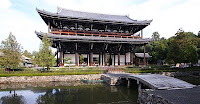Temples are the places of worship in Japanese Buddhism. Virtually every Japanese municipality has at least one temple, while large cultural centers like Kyoto have several thousands.
Temples store and display sacred Buddhist objects. Some temples used to be monasteries, and some still function as such. Structures typically found at Japanese temples are:
| Main hall The sacred objects of worship, such as statues, are displayed in the main hall. Main halls are called kondo, hondo, butsuden, amidado or hatto in Japanese. Example: Main hall of Todaiji in Nara. | |
| Lecture hall Lecture halls are for meetings and lectures and often also display objects of worship. Lecture halls are called kodo. Example: Lecture hall of Toji in Kyoto. | |
| Pagoda The pagoda, a structure that has evolved from the Indian stupa, usually comes with three (sanju no to) or five (goju no to) stories. Pagodas store remains of the Buddha such as a tooth, usually in form of a representation. Example: 3-storied pagoda of Kofukuji in Nara. | |
| Gates Gates mark the entrance to the temple grounds. There is usually one main gate, and possibly several additional gates, along the temple's main approach. Example: Sanmon Gate of Kenchoji in Kamakura. | |
| Bell On New Year's Eve, temple bells are rung 108 times, corresponding to the Buddhist concept of 108 worldly desires. Example: Great Bell of Kenchoji in Kamakura. | |
| Cemetery Most cemeteries in Japan are Buddhist and are located at a temple. The Japanese visit their ancestors' graves on many occasions during the year, especially during the obon week, the equinoctial weeks and anniversaries. |
The best cities to visit temples are Kyoto, Nara and Kamakura. One of the best places to overnight at temples is Mount Koya.
List Of Temples:
Osorezan (Mount Osore)
Osorezan (Mount Osore) is ranked along with Koyasan and Hieizan as one of Japan's three most sacred places. It was discovered over 1000 years ago by a Buddhist priest in search of a sacred mountain that resembles the world of Buddha. Today, it is the site of Bodaiji Temple.
[Read more of this review]
(Kamakura Daibutsu)
The statue was cast in 1252 and originally located inside a large temple hall
[Read more of this review]
Kiyomizudera Temple-Kyoto
Kiyomizudera ("Pure Water Temple") is one of the most celebrated temples of Japan. It was founded in 780 on the site of the Otowa Waterfall in the wooded hills east of Kyoto, and derives its name from the fall's pure waters. The temple was originally associated with the Hosso sect, one of the oldest schools within Japanese Buddhism, but formed its own Kita Hosso sect in 1965. In 1994, the temple was added to the list of UNESCO world heritage sites.
[Read more of this review]
Kinkakuji Temple-Kyoto
Kinkakuji (Golden Pavilion) is a Zen temple in northern Kyoto whose top two floors are completely covered in gold leaf. Formally known as Rokuonji, the temple was the retirement villa of the shogun Ashikaga Yoshimitsu, and according to his will it became a Zen temple of the Rinzai sect after his death in 1408. Kinkakuji was the inspiration for the similarly named Ginkakuji (Silver Pavilion), built by Yoshimitsu's grandson, Ashikaga Yoshimasa, on the other side of the city a few decades later.
[Read more of this review]
Kokodera(Moss Temple)
Kokedera means Moss Temple, referring to the temple garden's estimated 120 different varieties of moss. Visitors to the temple can walk through this spectacular garden, which has strongly influenced subsequent Japanese garden design.
[Read more of this review]
Ginkakuji (Silver Pavilion)
Ginkakuji (Silver Pavilion) is a Zen temple at the foot of Kyoto's eastern mountains (Higashiyama). In 1482, shogun Ashikaga Yoshimasa built his retirement villa on the grounds of today's temple, modeling it after Kinkakuji (Golden Pavilion), his grandfather's retirement villa at the base of Kyoto's northern mountains (Kitayama). The villa was converted into a Zen temple after Yoshimasa's death in 1490.
[Read more of this review]
Todaiji (Great Eastern Temple)
Todaiji was constructed in 752 as the head temple of all provincial Buddhist temples of Japan and grew so powerful that the capital was moved from Nara to Nagaoka in 784 in order to lower the temple's influence on government affairs.
[Read more of this review]
Hasedera Temple
Hasedera Temple is located in the mountains east of the Asuka region. The temple was founded in 686, and now serves as the head temple of the Bunzan school of Shingon Buddhism. Situated in a valley, Hasedera has over 30 buildings built up along the hillside that visitors can spend a long time exploring.
[Read more of this review]
Muroji Temple
Muroji is a large temple located in the mountains of eastern Nara Prefecture. Stone steps connect the buildings of the mountainside temple, leading through a dense forest. Many of the temple buildings date back hundreds of years, and the old wooden buildings create a harmonious atmosphere with the surrounding nature. Muroji makes an interesting comparison to the nearby Hasedera Temple, whose grounds have been more developed.
[Read more of this review]
Tofukuji Temple
Tofukuji is a large Zen temple in southeastern Kyoto that is particularly famous for its spectacular autumn colors. The temple was founded in 1236 at the behest of the powerful Fujiwara clan. Its name is a combination of the names of two great temples in Nara that were also associated with the Fujiwara, Todaiji Temple and Kofukuji Temple. Tofukuji has historically been one of the principal Zen temples in Kyoto, and is a head temple of one of the schools of the Rinzai sect of Zen Buddhism.
[Read more of this review]














No comments:
Post a Comment